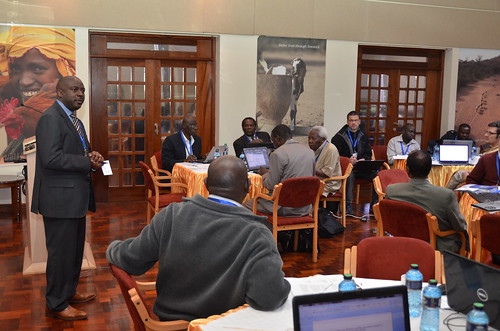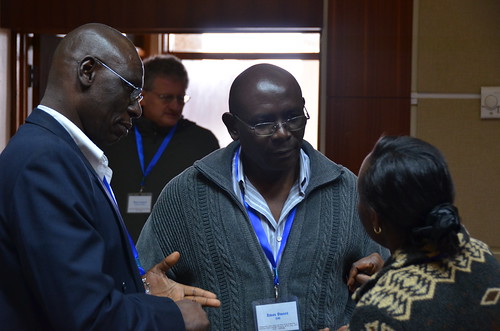A meeting to review research results from a dairy goat and root crop project in Tanzania was held in Nairobi last week (photo credit: ILRI/Paul Karaimu).
Last week (18-20 Jun 2013) the Nairobi campus of the International Livestock Research Institute (ILRI) hosted partners in a crop and goat project working to improve food security in Tanzania. The meeting reviewed research results from the two-year-old project.
This project is helping Tanzanian farmers integrate their dairy goat production with growing root crops. It’s raising incomes by improving the milk production potential of dairy goats, introducing improved sweet potato and cassava varieties and improving marketing options for goats and crops in Tanzania’s Kongwa and Mvomero districts.
Led by Tanzania’s Sokoine University of Agriculture and the University of Alberta in Canada, the project also involves collaboration with an agricultural research institute in Kibaha, the Kongwa and Mvomero district councils and the Foundation for Sustainable Rural Development, a non-governmental organization in the country. ILRI is serving as knowledge-support partner for the project and is providing expertise on goat production, gender issues and monitoring and evaluation.
Started in March 2011, the project is funded by the Canadian International Development Research Centre (IDRC) and the Canadian International Development Agency. The project brings together farmers and scientists in setting up community-managed breeding programs for dairy goats and introducing improved varieties of cassava and sweet potato in agro-pastoral area of the two districts. Previously, dairy goat keeping was restricted to wetter areas of the districts.
‘This is one of few projects whose achievements so far the IDRC is proud of and it stands a good chance for being considered for funding for scaling-up under the Food Security Research Fund,’ said Pascal Sanginga, of IDRC.
The program’s interventions have focused on understanding women’s roles in livestock activities such as feeding and milking, getting more women involved in livestock keeping and increasing women’s access to, and control over, benefits from livestock rearing and farming.
‘This project highlights the central role of partnerships in ILRI’s work in Tanzania, which is a focus country for the CGIAR Research Program on Livestock and Fish,’ says Amos Omore, the project’s coordinator at ILRI.
Participants in the meeting, who included graduate students and faculty from Sokoine and Alberta universities and researchers from ILRI, shared 16 research presentations, which will now be reworked as papers for submission to scientific journals. Feedback from these presentations guided a project evaluation and planning session that followed the workshop.
‘We’re learning about the challenges in establishing root crops and dairy goat production in marginal environments where there is a high variability in rainfall and stiff competition from pastoralism,’ said John Parkins, of Alberta University.
The project, which is reaching more than 100 farmers, has conducted a baseline study and has developed gender and monitoring & evaluation strategies.
Findings from this workshop, which included determination of specific environmental constraints and the costs and benefits of adopting new varieties of sweet potatoes and cassava, guided preparation of a proposal to scale up the project’s interventions. This proposal will be used to implement the final phase of the project, which ends in August 2014.
‘This meeting revealed a need to focus on doing a few things well—like facilitating fodder production, animal health and disease control,’ said Parkins.
View presentations from the meeting:
Read more about the project, ‘Integrating dairy goats and root crop production for increasing food, nutrition and income security of smallholder farmers in Tanzania’, http://ilri.org/node/1177 and https://sites.google.com/a/ualberta.ca/diary-goats-and-root-crops-tanzania/home. Download a project brochure
Read an ILRI news article about the project: Cassava and sweet potato may improve dairy goat production in Tanzania’s drylands, but will women benefit?



This is encouraging, however – why only dairy goats? Meat goats are the preferred type in much of Tanzania – as here in Burundi and elsewhere in sub-Saharan Africa.
Good questions. We also cross-breed with the local east africa goats to improve quality of local herds. We think there are good synergies been improved milk and meat production.